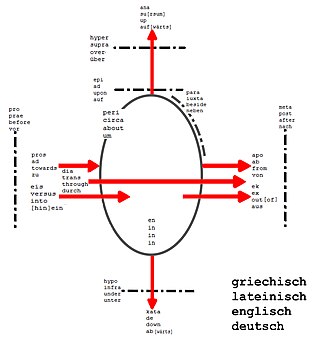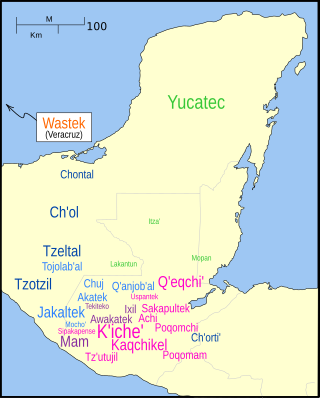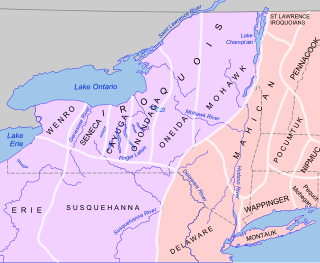In linguistics, an affix is a morpheme that is attached to a word stem to form a new word or word form. Affixes may be derivational, like English -ness and pre-, or inflectional, like English plural -s and past tense -ed. They are bound morphemes by definition; prefixes and suffixes may be separable affixes. Affixation is the linguistic process that speakers use to form different words by adding morphemes at the beginning (prefixation), the middle (infixation) or the end (suffixation) of words.
A morpheme is the smallest meaningful constituent of a linguistic expression. The field of linguistic study dedicated to morphemes is called morphology.
In linguistics, morphology is the study of words, how they are formed, and their relationship to other words in the same language. It analyzes the structure of words and parts of words such as stems, root words, prefixes, and suffixes. Morphology also looks at parts of speech, intonation and stress, and the ways context can change a word's pronunciation and meaning. Morphology differs from morphological typology, which is the classification of languages based on their use of words, and lexicology, which is the study of words and how they make up a language's vocabulary.

A prefix is an affix which is placed before the stem of a word. Particularly in the study of languages, a prefix is also called a preformative, because it alters the form of the word to which it is affixed.
Morphological derivation, in linguistics, is the process of forming a new word from an existing word, often by adding a prefix or suffix, such as un- or -ness. For example, unhappy and happiness derive from the root word happy.
A root is the core of a word that is irreducible into more meaningful elements. In morphology, a root is a morphologically simple unit which can be left bare or to which a prefix or a suffix can attach. The root word is the primary lexical unit of a word, and of a word family, which carries aspects of semantic content and cannot be reduced into smaller constituents. Content words in nearly all languages contain, and may consist only of, root morphemes. However, sometimes the term "root" is also used to describe the word without its inflectional endings, but with its lexical endings in place. For example, chatters has the inflectional root or lemma chatter, but the lexical root chat. Inflectional roots are often called stems, and a root in the stricter sense, a root morpheme, may be thought of as a monomorphemic stem.
In generative linguistics, Distributed Morphology is a theoretical framework introduced in 1993 by Morris Halle and Alec Marantz. The central claim of Distributed Morphology is that there is no divide between the construction of words and sentences. The syntax is the single generative engine that forms sound-meaning correspondences, both complex phrases and complex words. This approach challenges the traditional notion of the Lexicon as the unit where derived words are formed and idiosyncratic word-meaning correspondences are stored. In Distributed Morphology there is no unified Lexicon as in earlier generative treatments of word-formation. Rather, the functions that other theories ascribe to the Lexicon are distributed among other components of the grammar.

Tzeltal or Tseltal is a Mayan language spoken in the Mexican state of Chiapas, mostly in the municipalities of Ocosingo, Altamirano, Huixtán, Tenejapa, Yajalón, Chanal, Sitalá, Amatenango del Valle, Socoltenango, Las Rosas, Chilón, San Juan Cancuc, San Cristóbal de las Casas and Oxchuc. Tzeltal is one of many Mayan languages spoken near this eastern region of Chiapas, including Tzotzil, Chʼol, and Tojolabʼal, among others. There is also a small Tzeltal diaspora in other parts of Mexico and the United States, primarily as a result of unfavorable economic conditions in Chiapas.
In linguistics, a word stem is a part of a word responsible for its lexical meaning. The term is used with slightly different meanings depending on the morphology of the language in question. In Athabaskan linguistics, for example, a verb stem is a root that cannot appear on its own and that carries the tone of the word.

A word is a basic element of language that carries an objective or practical meaning, can be used on its own, and is uninterruptible. Despite the fact that language speakers often have an intuitive grasp of what a word is, there is no consensus among linguists on its definition and numerous attempts to find specific criteria of the concept remain controversial. Different standards have been proposed, depending on the theoretical background and descriptive context; these do not converge on a single definition. Some specific definitions of the term "word" are employed to convey its different meanings at different levels of description, for example based on phonological, grammatical or orthographic basis. Others suggest that the concept is simply a convention used in everyday situations.

Seneca (; in Seneca, Onöndowaʼga꞉ʼ Gawë꞉noʼ, or Onötowáʼka꞉, is the language of the Seneca people, one of the Six Nations of the Hodinöhsö꞉niʼ ; it is an Iroquoian language, spoken at the time of contact in the western part of New York. While the name Seneca, attested as early as the seventeenth century, is of obscure origins, the endonym Onödowáʼga꞉ translates to "those of the big hill." About 10,000 Seneca live in the United States and Canada, primarily on reservations in western New York, with others living in Oklahoma and near Brantford, Ontario. As of 2013, an active language revitalization program is underway.

Eastern Pomo, also known as Clear Lake Pomo, is a nearly extinct Pomoan language spoken around Clear Lake in Lake County, California by one of the Pomo peoples.
The Yimas language is spoken by the Yimas people, who populate the Sepik River Basin region of Papua New Guinea. It is spoken primarily in Yimas village, Karawari Rural LLG, East Sepik Province. It is a member of the Lower-Sepik language family. All 250-300 speakers of Yimas live in two villages along the lower reaches of the Arafundi River, which stems from a tributary of the Sepik River known as the Karawari River.
In linguistics, particularly linguistic morphology, bracketing is a term of art that refers to how an utterance can be represented as a hierarchical tree of constituent parts. Analysis techniques based on bracketing are used at different levels of grammar, but are particularly associated with morphologically complex words.
English prefixes are affixes that are added before either simple roots or complex bases consisting of (a) a root and other affixes, (b) multiple roots, or (c) multiple roots and other affixes. Examples of these follow:

The Nukak language is a language of uncertain classification, perhaps part of the macrofamily Puinave-Maku. It is very closely related to Kakwa.
Paamese, or Paama, is the language of the island of Paama in Northern Vanuatu. There is no indigenous term for the language; however linguists have adopted the term Paamese to refer to it. Both a grammar and a dictionary of Paamese have been produced by Terry Crowley.
Odia grammar is the study of the morphological and syntactic structures, word order, case inflections, verb conjugation and other grammatical structures of Odia, an Indo-Aryan language spoken in South Asia.
Moro is a Kordofanian language spoken in the Nuba Mountains of South Kordofan, Sudan. It is part of the Western group of West Central Heiban Kordofonian languages and belongs to the Niger-Congo phylum. In 1982 there were an estimate of 30.000 Moro-speakers. This was before the second Sudan civil war and therefore the recent number of speakers might differ. There can be noted an influence of Arabic and it is suspected that today approximately a fourth of all Moro vocabulary has a relation or an origin in the Arabic language.
Vamale (Pamale) is a Kanak language of northern New Caledonia. The Hmwaeke dialect, spoken in Tiéta, is fusing with Haveke and nearly extinct. Vamale is nowadays spoken in Tiendanite, We Hava, Téganpaïk and Tiouandé. It was spoken in the Pamale valley and its tributaries Vawe and Usa until the colonial war of 1917, when its speakers were displaced.









